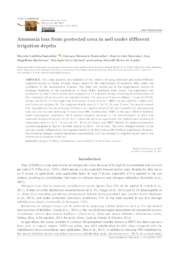Ammonia loss from protected urea in soil under different irrigation depths.
Ammonia loss from protected urea in soil under different irrigation depths.
Autoria: ESPINDULA, M. C.; RODOVALHO, G. M.; MARCOLAN, A. L.; BARBERENA, I. M.; CIPRIANI, H. N.; ARAÚJO, L. F. B. de
Resumo: This study presents an evaluation of the viability of using protected urea under different irrigation depths to reduce nitrogen losses caused by the volatilization of ammonia (NH3) under the conditions of the Southwestern Amazon. The study was carried out at the Experimental Station of Embrapa Rondônia, in the municipality of Porto Velho, Rondônia State, Brazil. The experiment was conducted in a Red-Yellow Latosol and arranged in a 5 x 6 factorial design consisting of a combination of five treatments (N sources) with six irrigation depths. The sources of N were as follows: 1) urea (45.5% N); 2) urea (44.3% N) + 0.15% copper and 0.4% boron; 3) urea (45% N) + NBPT; 4) urea (43% N) + sulfur (1%); and 5) control (without N). The irrigation depths were 0, 5, 10, 15, 20, and 25 mm. The results showed that, regardless of the use of urease inhibitors, an irrigation depth of 10 mm is suitable for incorporating urea into the soil and stabilizing N losses from NH3 volatilization. NBPT is the most efficient inhibitor under nonirrigated conditions. All N sources promote increases in the concentrations of nitric and ammonia nitrogen in the soil. In the first 15 days after fertilizer application, the highest concentrations of ammonium were in the 0 - 10 cm and 10 - 20 cm soil layers, and NBPT showed the highest ammonium content compared to that of the other sources in the 0 - 10 cm layer. The nitric nitrogen content in the soil was slightly influenced by the irrigation depth in the first 15 days after fertilizer application. However, the ammonia nitrogen content decreased exponentially with the increase in irrigation depth due to the movement of ammonia in the soil.
Ano de publicação: 2021
Tipo de publicação: Artigo de periódico
Unidade: Embrapa Rondônia
Palavras-chave: Amazônia Ocidental, Ammonium nitrogen, Amônia, Campo Experimental, Demonstration farms, Embrapa Rondônia, Irrigation depths, Irrigação, Latossolo Vermelho-Amarelo, Nitrogênio, Perda, Porto Velho (RO), Protected urea, Red-Yellow Latosol, Rondônia, South Western Amazon, Urease inhibitors, Uréia, Uréia protegida, Volatilization, Volatilização
Observações
1 - Por padrão são exibidas publicações dos últimos 20 anos. Para encontrar publicações mais antigas, configure o filtro ano de publicação, colocando o ano a partir do qual você deseja encontrar publicações. O filtro está na coluna da esquerda na busca acima.
2 - Para ler algumas publicações da Embrapa (apenas as que estão em formato ePub), é necessário ter, no celular ou computador, um desses softwares gratuitos. Sistemas Android: Google Play Livros; IOS: iBooks; Windows e Linux: software Calibre.
Acesse outras publicações
Acesse a Base de Dados da Pesquisa Agropecuária (BDPA) para consultar o acervo completo das bibliotecas da Embrapa.

